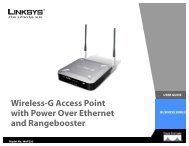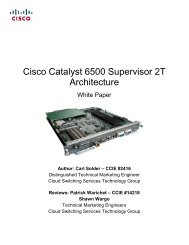Cisco Small Business RV 120W Wireless-N VPN Firewall ...
Cisco Small Business RV 120W Wireless-N VPN Firewall ...
Cisco Small Business RV 120W Wireless-N VPN Firewall ...
Create successful ePaper yourself
Turn your PDF publications into a flip-book with our unique Google optimized e-Paper software.
Configuring the <strong>Firewall</strong><strong>Cisco</strong> <strong>RV</strong><strong>120W</strong> <strong>Firewall</strong> Features4• Schedules as to when the router should apply rules.• Keywords (in a domain name or on a URL of a web page) that the routershould allow or block.• MAC addresses of devices whose inbound access to your network therouter should block.• Port triggers that signal the router to allow or block access to specifiedservices as defined by port number.• Reports and alerts that you want the router to send to you.You can, for example, establish restricted-access policies based on time-of-day,web addresses, and web address keywords. You can block Internet access byapplications and services on the LAN, such as chat rooms or games. You can blockjust certain groups of PCs on your network from being accessed by the WAN orpublic network.Inbound (Internet to LAN) rules restrict access to traffic entering your network,selectively allowing only specific outside users to access specific local resources.By default, all access from the insecure WAN side is blocked from accessing thesecure LAN, except in response to requests from the LAN or DMZ. To allowoutside devices to access services on the secure LAN, you must create a firewallrule for each service.If you want to allow incoming traffic, you must make the router's WAN port IPaddress known to the public. This is called “exposing your host.” How you makeyour address known depends on how the WAN ports are configured; for the<strong>Cisco</strong> <strong>RV</strong><strong>120W</strong>, you may use the IP address if a static address is assigned to theWAN port, or if your WAN address is dynamic, a DDNS (Dynamic DNS) name canbe used.Outbound (LAN to Internet) rules restrict access to traffic leaving your network,selectively allowing only specific local users to access specific outside resources.The default outbound rule is to allow access from the secure zone (LAN) to theinsecure WAN. To block hosts on the secure LAN from accessing services on theoutside (insecure WAN), you must create a firewall rule for each service.<strong>Cisco</strong> <strong>RV</strong><strong>120W</strong> Administration Guide 66
















